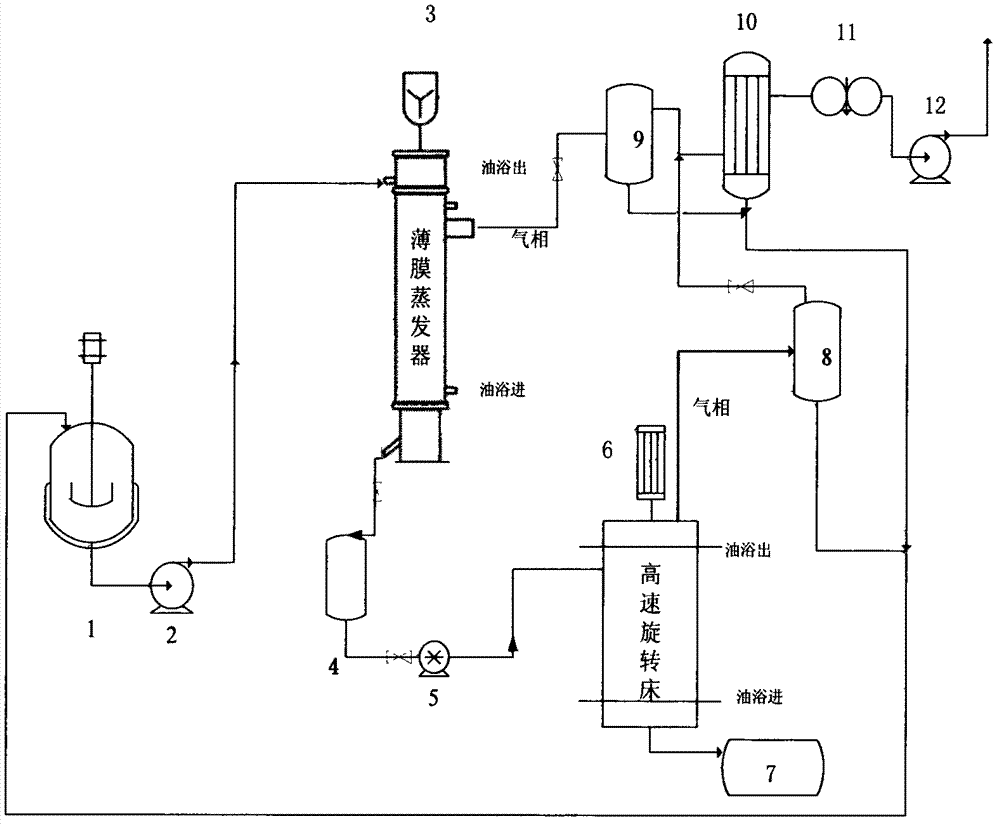Method for preparing polyurethane curing agent
A technology of polyurethane curing agent and curing agent, which is applied in the direction of chemical instruments and methods, polyurea/polyurethane coating, urea derivative preparation, etc. It can solve the problems of adverse effects of end use and improvement, difficulty in volatilization of entraining agent, difficulty in recycling, etc. , to achieve the effects of reducing operating costs and investment costs, high gas-liquid mass transfer efficiency, and easy replacement of material systems
- Summary
- Abstract
- Description
- Claims
- Application Information
AI Technical Summary
Problems solved by technology
Method used
Image
Examples
Embodiment 1
[0053] Using the above-mentioned process steps, add 100kg of hexamethylene diisocyanate (HDI) in the normal pressure reactor, stir and heat up after nitrogen replacement, add catalyst 0.3kg phosphoric acid bis(2-ethylhexyl) after mixing, 2kg distilled water passes through The nozzle is sprayed into the reaction kettle, and the addition is completed in 2 hours. After spraying, the temperature is raised to 130°C and kept for 2 hours. The reaction liquid enters the thin film evaporator for separation. The separation temperature is 150°C and the separation pressure is 300Pa. The obtained separated heavy component enters the high-speed rotary bed at a speed of 15m / s, and the secondary separation is carried out under the condition of setting the rotational speed of the rotary bed at 300rpm. After separation, the HDI biuret product is obtained, and its free HDI mass content is 0.38%, and the NCO content is 0.38%. It is 21.7%, viscosity 9360cp.
Embodiment 2
[0055] In a reaction kettle with a thermometer, agitator, and reflux condenser, mix HDI and IPDI at a mass ratio of 1:1, the molar ratio is (5.9:4.5), replace with nitrogen, and heat the reactant to 55°C , based on the quality of HDI and IPDI, 400ppm tri-n-butylphosphine was added to keep the reaction temperature not exceeding 65°C, and the NCO% of the mixed reaction solution was 33.9%. After 15 hours of reaction, 500ppm phosphoric acid was added to terminate the reaction. The primary separation temperature is 120°C and the separation pressure is 1000Pa. The obtained separated heavy component enters the high-speed rotary bed at a speed of 10m / s, and the secondary separation is carried out at the speed of the rotary bed at 400rpm. It is an oligomer of 8630cp / 25°C, the NCO content is 19.8%, and the residual monomer content is 0.18% HDI and 0.14% IPDI respectively. Then pump it into the dilute container, configure it as a 50% solvent at 100°C, and obtain the product.
Embodiment 3
[0057] In a reaction kettle with a thermometer, agitator, and reflux condenser, add HDI, replace with nitrogen, heat the reactant to 55°C, and gradually add 700ppm quaternary ammonium salt catalyst DABCO based on the quality of HDI The reaction temperature does not exceed 70°C, the NCO% of the mixed reaction liquid is 38.1%, and 600ppm benzoyl chloride is added to terminate the reaction. The prepared HDI trimer reaction liquid is subjected to primary separation at 130°C and 1000Pa through a primary thin film evaporator , the free monomer content of the obtained isolated heavy fraction was 8.1%, and the viscosity was 947cp / 25°C. Enter the high-speed rotating bed at a speed of 20m / s, set the temperature of the rotating bed at 150°C, the pressure at 30Pa, and the rotation speed at 200rpm for secondary separation, and then put it into the product storage tank to obtain the product. The free HDI mass content 0.2%.
PUM
| Property | Measurement | Unit |
|---|---|---|
| diameter | aaaaa | aaaaa |
| diameter | aaaaa | aaaaa |
| diameter | aaaaa | aaaaa |
Abstract
Description
Claims
Application Information
 Login to View More
Login to View More - R&D
- Intellectual Property
- Life Sciences
- Materials
- Tech Scout
- Unparalleled Data Quality
- Higher Quality Content
- 60% Fewer Hallucinations
Browse by: Latest US Patents, China's latest patents, Technical Efficacy Thesaurus, Application Domain, Technology Topic, Popular Technical Reports.
© 2025 PatSnap. All rights reserved.Legal|Privacy policy|Modern Slavery Act Transparency Statement|Sitemap|About US| Contact US: help@patsnap.com


